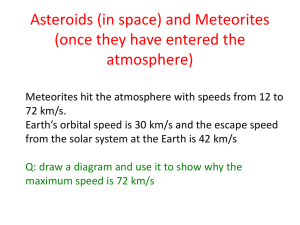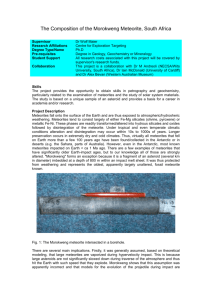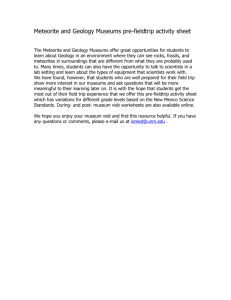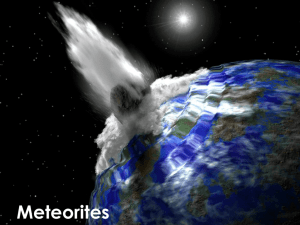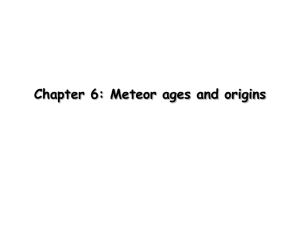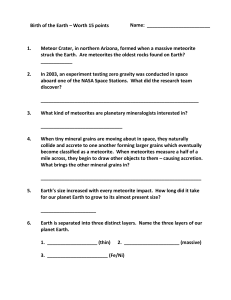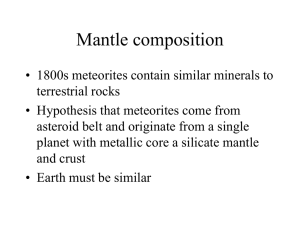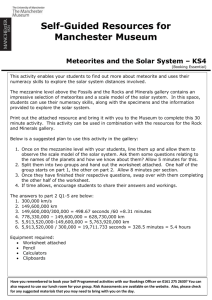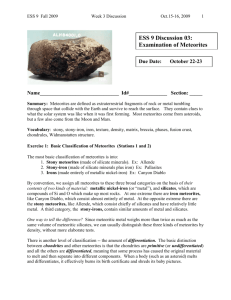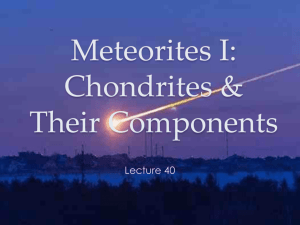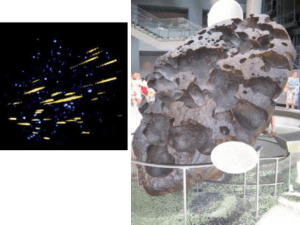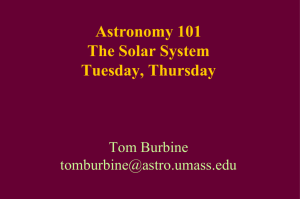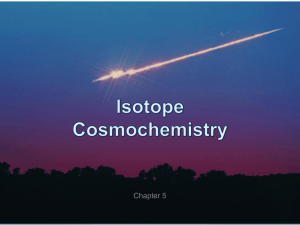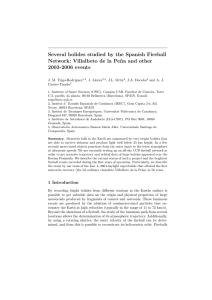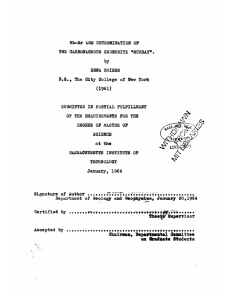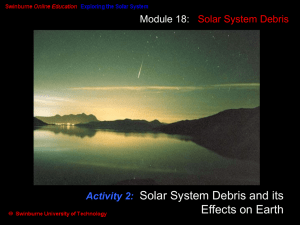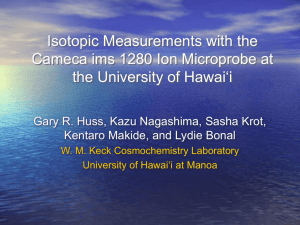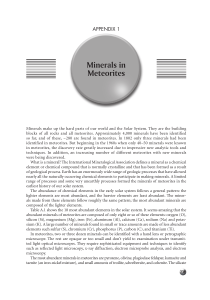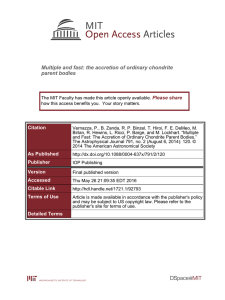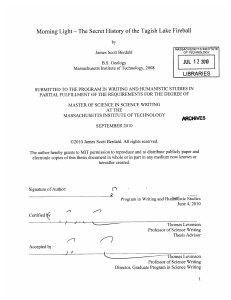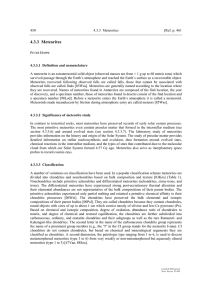here
advertisement
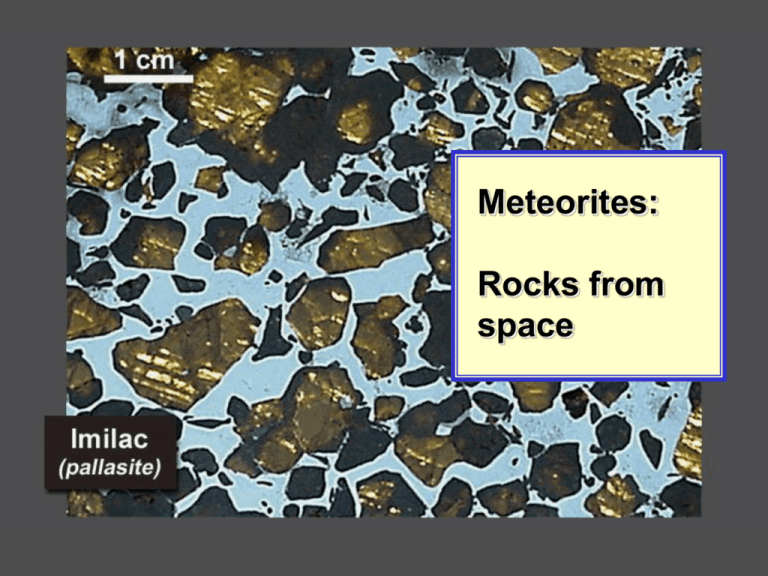
Meteorites: Rocks from space Leonid meteor shower, 1998 European Fireball Network image Meteoroid Meteor (fireball) Meteorite 1992 Peekskill fireball video clips (How to turn a $300 car into one worth $10,000.) Results of ablation: fusion crust, thumbprints, fragmentation Where do meteorites come from? Well-photographed meteors which have produced meteorites: Pribram, Czechoslovakia Lost City, Oklahoma Innisfree, Alberta Peekskill, New York Tagish Lake, British Columbia Tagish Lake fireball 1959 1970 1977 1992 2000 H5 H5 LL5 H6 CM1 Meteoroid orbits: aphelia between Mars & Jupiter (asteroid belt) Jupiter Mars Spectral reflectance of various meteorites & asteroids How do meteorites get to the Earth? (1) Perturbations by Jupiter can put asteroidal material into Earth-crossing orbits (Kirkwood gap clearing). (2) The Yarkovsky Effect can cause rotating m-sized objects to spiral inwards to (or outwards from) the sun. Cosmic-ray exposure (CRE) ages of meteorites (~1 Ma to ~0.5 Ga) give travel time needed for m-sized object-- consistent with Yarkovsky Effect Meteorites: different types Designation Proportion of metal & silicate Stony >> 50 % silicate Stony-iron ~ 50% metal, ~ 50% silicate) Iron >> 50% metal alloy Meteorite types & parent bodies Designation Class & rock types # parent bodies* Stony Stony chondrites: agglomerate achondrites: igneous, breccia > 13 >8 Stony-iron Stony-iron pallasite: igneous mesosiderite: meta-breccia >3 1 (2) Iron many groups: igneous 50-80? * as inferred from chemical & isotopic studies Meteorites: different types Designation Type of rock Chondrite (stony) agglomerate-- never melted All else (stony, stonyiron, iron) igneous; impact breccias-melted at least once Chondrites All other rocks Undifferentiated meteorites: chondrites Chondrites • Meteorite type most often seen to fall (85.6%) • Earliest-formed rocks (ages: ~4.55 b.y.) • Formed in solar nebula • Solar-like bulk composition (planetary building blocks) protoplanetary disks Chondrites have “solar composition” for most elements Chondrites • most contain chondrules mm to sub-mm-sized objects formed as melted dispersed objects • some contain refractory inclusions (CAIs) mm to cm-sized objects formed at high temperatures in solar nebula • some contain pre-solar grains grains formed around other stars • some contain pre-biotic organic matter matrix chondrules 0.2 mm “Chondritic texture”: an agglomeration of chondrules and fine-grained matrix CAIs contains CAIs and pre-solar grains CAIs chondrules Carbonaceous chondrite Image: J.A. Wood Contains pre-biotic organic material Carbonaceous vs. Ordinary Chondrites Shocked chondrite: the 1992 Peekskill Fireball meteorite Gibeon (IVA iron) Differentiated meteorites DAG 485 (urelilite) Millbillillie (eucrite) Achondrite - any stony meteorite NOT a chondrite - samples of crusts and mantles of differentiated asteroids, the Moon, and Mars Irons - samples of the cores of differentiated asteroids Big! iron meteorite Iron meteorite: slow-cooling in a metallic core Mesosiderite origin: collision of a stripped metal core & another differentiated asteroid? Studies of meteorites provide evidence for: 1) widespread transient, high-T heating events in the solar nebula -- to form chondrules, CAIs 2) gas-dust chemical equilibrium in the solar nebula -- “equilibrium condensation model” valid 3) incomplete mixing & heating of dust in the solar nebula -- pre-solar material survived solar system formation! Studies of meteorites provide evidence for: 4) short-lived heat sources in meteorite parent bodies -- many asteroids melted & differentiated -- many asteroids metamorphosed & aqueously altered -- short-lived radionuclides, induction heating (?) were important in early solar system 5) water in many meteorite parent bodies -- in the form of ice or hydrated materials -- water in some asteroids too Studies of meteorites provide evidence for: 6) pre-biotic organic synthesis -- precursor materials for life formed in space! 7) impact & collision processes -- collisions important, probably even early in solar system -- asteroids may have been disrupted & reassembled Studies of meteorites provide evidence for: 8) interplanetary rock-swapping -- we have martian & lunar meteorites -- this has implications for life

